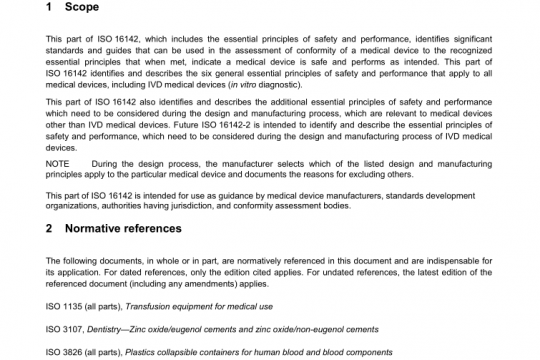AAMI ST35 pdf free download
AAMI ST35 pdf free download.Safe handling and biological decontamination of reusable medical devices in health care facilities and in nonclinical settings.
2 Definitions, symbols, and abbreviations For the purposes of this recommended practice, the following definitions apply. 2.1 bioburden: Population of viable microorganisms on a product and/or package. NOTE—When measured, bioburden is expressed as the total count of bacterial and fungal colony-forming units per single item. 2.2 biofilm: Matrix that contains cells, living and dead, as well as polysaccharide (sometimes referred to as glycocalyx), and that is exuded by microorganisms when they are growing in water or water solutions or in vivo (e.g., the bloodstream). Biofilm prevents antimicrobial agents such as sterilants, disinfectants, and antibiotics from reaching the microorganisms. 2.3 CDC: Centers for Disease Control and Prevention. 2.4 cleaning: Removal of contamination from an item to the extent necessary for further processing or for the intended use. NOTE—In health care facilities, cleaning consists of the removal, usually with detergent and water, of adherent soil (e.g., blood, protein substances, and other debris) from the surfaces, crevices, serrations, joints, and lumens of instruments, devices, and equipment by a manual or mechanical process that prepares the items for safe handling and/or further decontamination. 2.5 contaminated: State of having been actually or potentially in contact with microorganisms. NOTE—As used in health care, the term generally refers to microorganisms that could be capable of producing disease or infection.2.6 decontamination: According to OSHA, “the use of physical or chemical means to remove, inactivate, or destroy bloodborne pathogens on a surface or item to the point where they are no longer capable of transmitting infectious particles and the surface or item is rendered safe for handling, use, or disposal” (29 CFR 1 91 0.1 030). NOTE—The term is generally used in health care facilities with reference to all pathogenic organisms, not just those transmitted by blood. 2.7 disinfection: Destruction of pathogenic and other microorganisms by thermal or chemical means. NOTE—Disinfection destroys most recognized pathogenic microorganisms but not necessarily all microbial forms such as bacterial spores. Disinfection processes do not ensure the margin of safety associated with sterilization processes. 2.8 engineering controls: According to OSHA, “controls (e.g., sharps disposal containers, self-sheathing needles) that isolate or remove the bloodborne pathogens hazard from the workplace” (29 CFR 1 91 0.1 030). NOTE—More generally, the term also refers to controls that reduce or remove other workplace hazards such as exposure to toxic chemicals. 2.9 EPA: Environmental Protection Agency. 2.10 exposure control plan: According to OSHA, “a written [plan] designed to eliminate or minimize employee exposure” (29 CFR 1 91 0.1 030). 2.11 FDA: Food and Drug Administration. 2.12 high-level disinfection: Process capable of killing all microorganisms with the exception of high numbers of bacterial spores. 2.13 intermediate-level disinfection: Process capable of killing the tubercle bacillus, vegetative bacteria, most viruses, and most fungi, but not necessarily bacterial spores. 2.14 liquid-proof material: Material that prevents the penetration of liquids and microorganisms. 2.15 liquid-resistant material: Material that inhibits the penetration of liquids. 2.16 low-level disinfection: Process capable of killing most bacteria, some viruses, and some fungi, but not the tubercle bacillus or bacterial spores.AAMI ST35 pdf download.
Other IEC Standards
-

ANSI AAMI ISO 16142-1 pdf free download – non-IVD medical devices and guidance on the selection of standards
AAMI standards list DOWNLOAD -

ANSI AAMI ISO 16142-2 pdf free download – General essential principles and additional specifc essential principles
AAMI standards list DOWNLOAD


